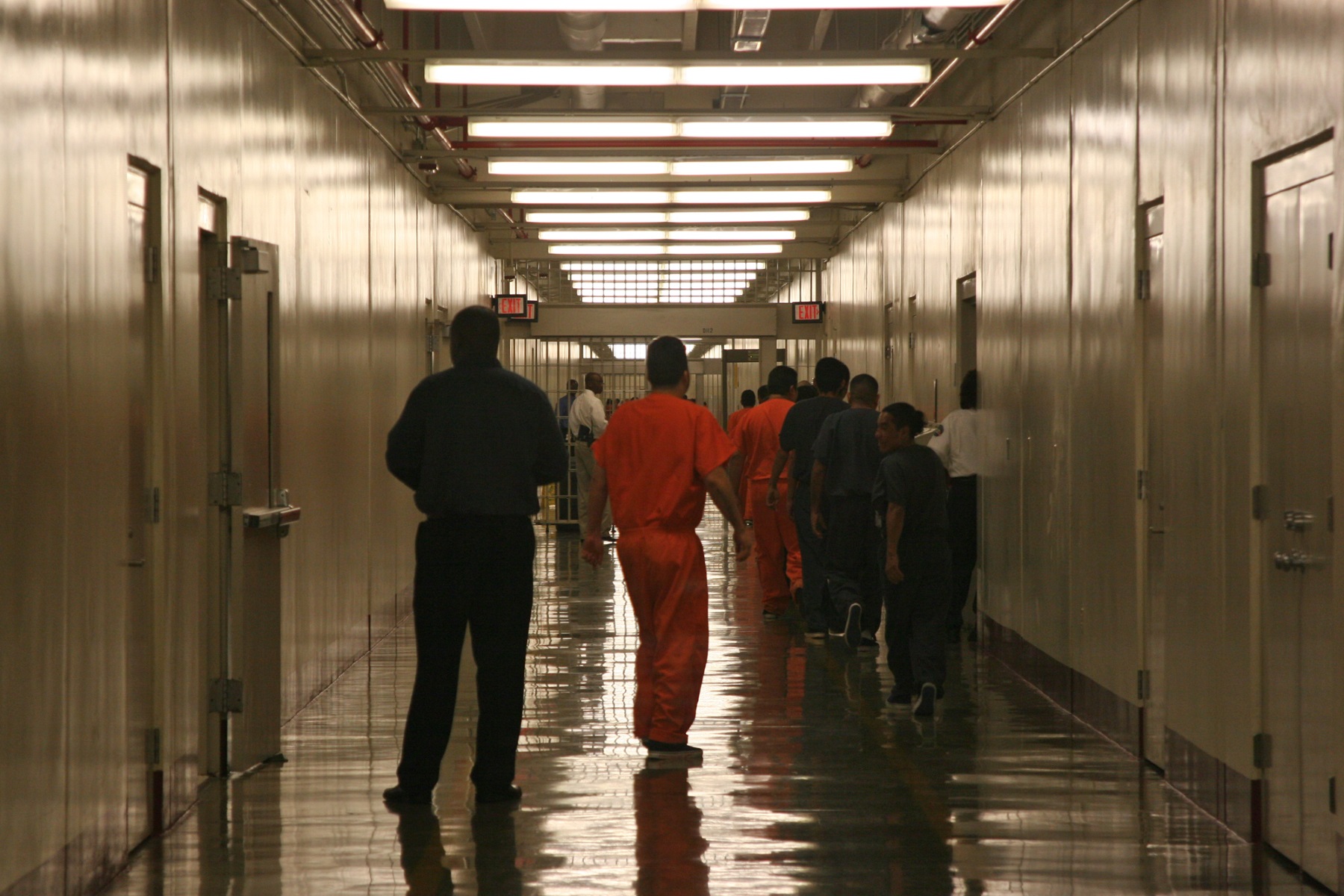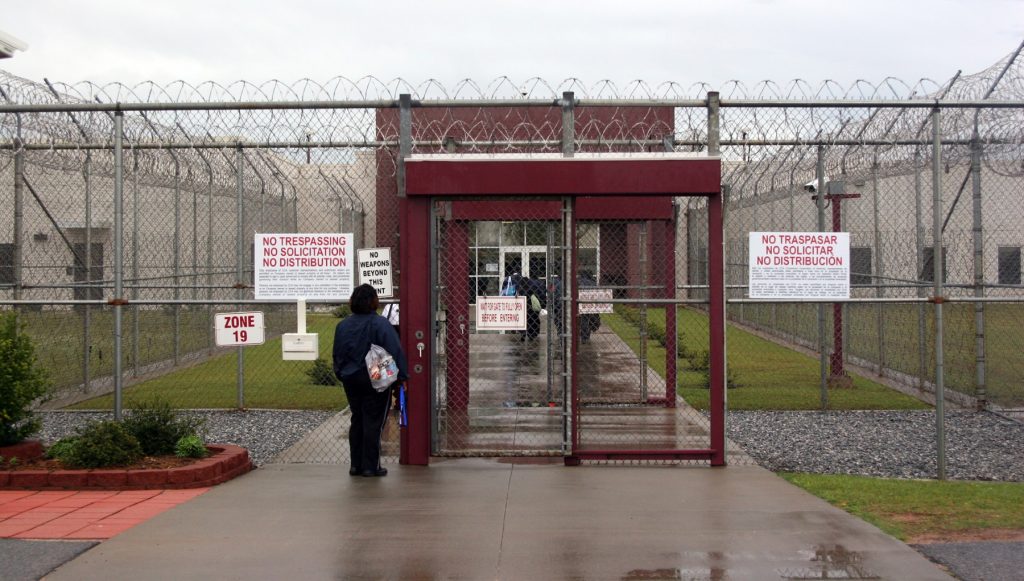Exclusive: An ICE Detention Center’s Struggle With ‘Chronic’ Staff Shortages

This 2009 photo shows a detainee at Stewart Detention Center in Lumpkin, Georgia, returning to the facility’s living units. An investigation from WABE and Reveal shows widespread issues existed at the center, including drug smuggling and staffing shortages.
Kate Brumback / Associated Press file
One of the country’s largest immigration detention centers had no psychiatrist on staff, “chronic shortages” of almost all medical positions and was described by its own staff as a “ticking bomb” because noncriminal detainees were mixed with high-security offenders.
Federal records obtained by WABE and Reveal from the Center for Investigative Reporting show the U.S. Department of Homeland Security Office of Inspector General found widespread problems at Stewart Detention Center in southwest Georgia, including drug smuggling and staffing shortages that employees said endangered detention officers and detainees.
Illegal drugs were “continuously coming into the facility,” federal inspectors wrote after speaking with the facility’s internal inspector. The inspector said that the DHS Office of Inspector General recently arrested “multiple employees for smuggling drugs into the facility.” The inspector and other officials interviewed as part of the investigation are not named in the records.
Some of those problems were mentioned in a report by the DHS Office of Inspector General released in December 2017. The report came after federal investigators looked into conditions at immigrant detention centers across the country, including Stewart Detention Center. The report concluded there were “problems that undermine the protection of detainees’ rights, their humane treatment, and the provision of a safe and healthy environment.”
However, striking details not included in the Office of Inspector General’s 19-page report are revealed in the inspection’s work papers. Those work papers — 88 pages of notes from interviews with Stewart Detention Center staff, detainees, and other documentation that went into the production of the report — were released to WABE and Reveal in response to a Freedom of Information Act request.
Two detainees who were being held at Stewart died within the same 12-month period. Jean Jimenez-Joseph, a 27-year-old from Panama, hanged himself with a bedsheet in May 2017 while in solitary confinement. Yulio Castro-Garrido, a 33-year-old from Cuba, died in January of this year after officials diagnosed him with pneumonia.
Staff Shortages ‘Pose A Risk’

Stewart Detention Center is in Lumpkin, Georgia — about 150 miles south of Atlanta. This U.S. Immigration and Customs Enforcement facility is operated by the private corrections company CoreCivic, formerly known as Corrections Corporation of America. The detention center can hold nearly 2,000 people and, at the time of the investigation, was near capacity.
Multiple employees at the facility brought up the issue of staffing shortages to inspectors. One CoreCivic manager said his biggest concern at Stewart Detention Center “is staffing shortages which pose a risk to the staff’s safety.”
Another CoreCivic employee said the facility has a shortage of detention officers “which makes it dangerous for the DO’s [detention officers] and the detainees,” and that “housing units are understaffed for the number of detainees on the units at the time,” the inspectors wrote.
The DHS Office of Inspector General also identified a shortage in the facility’s medical staff. According to federal records, ICE is responsible for detainees’ medical and mental health care at the facility. According to the inspector, Stewart’s health services administrator noted “chronic shortages of almost all medical staff positions.” As of February 2017, the facility had no psychiatrists and about one in four registered nurse positions were vacant.
Stewart’s health administrator told inspectors the facility covers its shortage of mental health professionals by “leaning heavily” on remaining licensed clinical social workers and on video-conferencing calls with psychiatrists. He also noted the lack of mental health treatment centers in the local area.
An ICE supervisor at the center told inspectors there weren’t enough ICE deportation officers and said there was high turnover. Records show there were 13 unfilled ICE officer positions, and for three years, there was no detention service manager on site — the person whose job it is to ensure that detention centers are safe and humane.
Bryan Cox, an ICE spokesman, told WABE that the staffing ratios at Stewart were “compliant with agency policy.” However, when asked about the staffing requirements, he said, “The staffing ratio is an internal policy that is not releasable.”
“‘Shortages’ is a somewhat editorial term,” Cox said. “Under ICE policy, there are staffing ratios that are required in various aspects, and so the opinion of ‘a short staff’ is a nontechnical term.”
Mistakes With Housing Detainees ‘A Ticking Bomb’
The facility also misclassified detainees, inspectors found. It categorizes and houses immigrants based on their criminal record. But a CoreCivic classification supervisor told the DHS Inspector General’s office that detainees are often misclassified because transfer records don’t always arrive at the Stewart Detention Center with the detainee.
Because of these delays, the CoreCivic supervisor said Stewart has housed felons with noncriminal detainees. She said this happened several times a week and called the delays “a ticking bomb.” She also said the facility was “often out of compliance” with processing detainees in a timely manner.
In another example of not receiving paperwork on time, an ICE supervisor told the DHS Office of Inspector General that the mailroom at Stewart was so hectic, it caused “delay in receiving some of the consular documents.” He said one Mexican detainee who was “easy to remove” stayed at Stewart for 87 days because some paperwork needed for deportation was lost in the CoreCivic mailroom.
The Office of Inspector General recommended in its 19-page public report that ICE improve its detention oversight procedures. ICE “concurred” with that recommendation.
CoreCivic spokeswoman Amanda Gilchrist said in an emailed statement, “CoreCivic cares deeply about every person in our care. Our immigration facilities are monitored very closely by the government, and each and every one is required to undergo regular review and audit processes that include ensuring an appropriate standard of living for all detainees.”
Gilchrist also said, “the issues identified by the December report were quickly and effectively remedied.”
Meanwhile, immigrant-rights advocates say there are ongoing issues at Stewart.
In April, civil rights groups, including the Southern Poverty Law Center, filed a lawsuit against CoreCivic, saying the private corrections company forces immigrant detainees to work at Stewart for less than $4 a day to pay for necessities including toilet paper and toothpaste.








